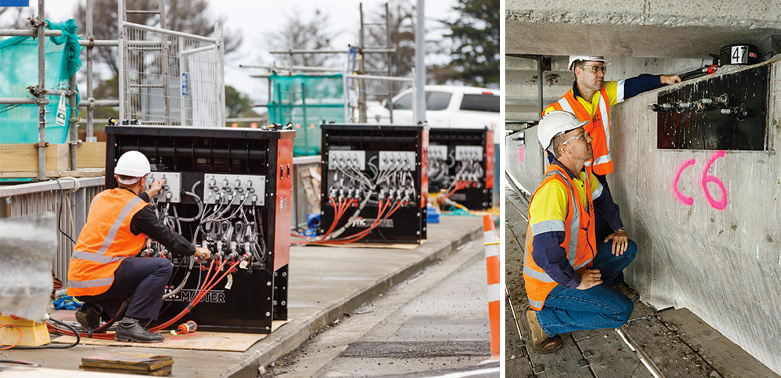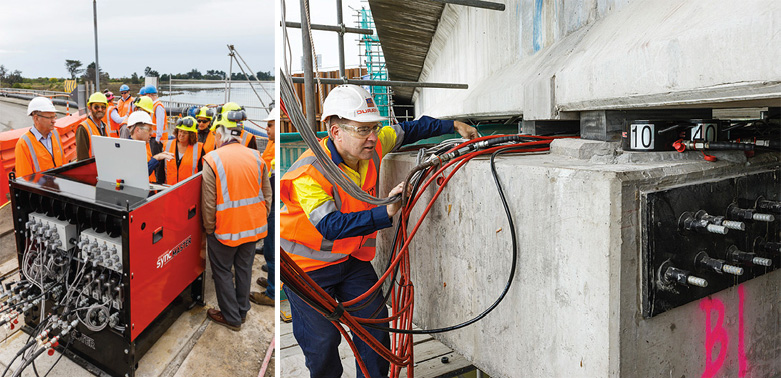Project Description
CHRISTCHURCH BRIDGE LIFT HERALDS NEW DAWN FOR HTC TECHNOLOGY IN INFRASTRUCTURE
When South New Brighton’s Bridge Street bridge was lifted in a sub-24-hour operation between 13 and 15 December 2013, it was the first time a maneuver of its type and technological complexity had been performed in New Zealand or Australia.
The raising of buildings and other infrastructure developments in order to move, alter or repair them is not new, but the Stronger Christchurch Infrastructure Rebuild Team (SCIRT) /Fulton Hogan Bridge Street project was remarkable in that we deployed a $1 million hydraulic lifting system to spread more than 7,200 tons of lift power across 72 separate hydraulic rams. The whole process, which had been a year in the planning and calculated to take between 12 and 24 hours from start to finish, was controlled from a single touch-screen display.

It was not our first involvement with bridge lifting – multiple lifts have been done in Christchurch in recent times and HTC teams in the past have provided the power to lift the Houses Of Parliament and to move the Museum Hotel in Wellington (the old-fashioned way) – but this was the most complex, and the technology is light years away from the old method of stationing workers at each lifting point to synchronise activity via walkie-talkie.
The computer-controlled lifting process reduces both risk and cost, both essential elements of a complex procedure to repair the bridge’s earthquake damaged foundations.
The new technology we used is the Durapac SYNCMASTER Synchronised Lifting System. HTC owns five units, which can be connected to create and control up to 40 lifting points. The ‘spread’ this permits is key for a weighty project such as Bridge Street, in which more lifting points meant less stress on the structure. It provides HTC with unique capability to complete large-scale construction and infrastructure projects. The Bridge Street bridge lift not only showcased progress in the Christchurch rebuild and construction industry evolution, its special nature has drawn some old-timers back to the game. An adviser that has supported HTC’s team of five, along with civil construction firm Fulton Hogan, part of SCIRT (Stronger Christchurch Infrastructure Rebuild Team) and project owner Christchurch City Council is Stuart Smith, who was involved in the process when the bridge was built in 1980. He came out of retirement to assist in the planning process, which began in late 2012.
HTC’s Christchurch branch manager Daniel Brice, the leader of our five strong project team, said, “It’s an exciting time for HTC. We have been fielding enquiries about this project from all over New Zealand and around the world, and we’re looking forward to the next challenge.”
Our Managing Director Robb Huskinson said, “We are excited about this project both for what it will do for the people of South New Brighton, who have been waiting patiently for two years for this essential infrastructure repair to restore a quick route to the CBD, and for what it means for our company.”
The purchase of five Durapac systems was a significant capital expenditure that was made with the knowledge that it would not only give us unique capability in our sector, but would open up a new income stream across New Zealand and in Australia, in that we are the only company with this size system available for hire. All five units can fit easily into one shipping container and then be set up ready to go on-site, so this service to the Australian market is viable and will meet a need across the Tasman.”
To allow media and members of the industry to have a look at the bridge jacking set-up, Fulton Hogan and HTC opened up the worksite for four hours on Wednesday 11 December. There they demonstrated the Durapac technology and showed how it is being put to use in the Christchurch rebuild and other large infrastructure projects around the country.


